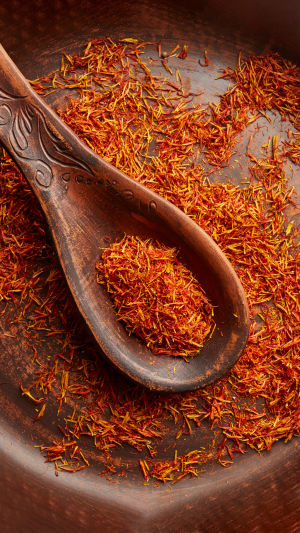Saffron, also known as Crocus sativus, originates from West Asia and belongs to the iris family.
Flourishing in cool, moist climates, it finds its true kingdom, contributing a staggering seventy to eighty percent of the world's annual saffron production.
Spain, Morocco, and the Kashmir region in India are also notable saffron producers.
Historically, saffron has held a significant role in culture, transitioning from a symbol of good fortune and holiness to a sought-after edible spice. Despite the deep red hue of its dried stamens, saffron transforms into a vibrant golden yellow when infused in water.
As the Persian empire expanded, so did the demand for saffron among the aristocracy. Unable to meet the growing needs locally, saffron cultivation spread along the eastern Mediterranean coast. This popularity extended to ancient Greece and Rome, where the nobility embraced saffron's allure.
Distinctive in its pricing, saffron is often measured in grams, with a few threads commanding prices comparable to rare delicacies like fish roe and truffles. Beyond its captivating flavor and unique color, the price reflects the labor-intensive cultivation process.
Botanically, saffron is a perennial herbaceous flower with underground roots and bulbs. Each bulb yields a dozen leaves, and short stems produce four small purple flowers that open sequentially. The prized spice, however, comes solely from the tiny, three-filamented style atop the plant.
Late fall marks the laborious saffron harvest when farmers meticulously pick the four flowers, one month apart. Timing is crucial; saffron must be gathered on the day each flower blooms, preferably after dawn when the flowers' water vapor slightly evaporates, enhancing the flavor.
Premium saffron comprises only the crimson column's top, requiring painstaking efforts. Obtaining a gram necessitates hundreds of flowers and numerous hours of labor. Some markets offer secondary saffron, mixed with the flower column base, exhibiting lighter color and flavor.
Known as "oro rosso" or red gold, saffron reached the region from Spain in the 13th century. As a lucrative crop, it is aptly sold in affluent areas like Milan and Venice, as well as international markets in France, Germany, and Austria. Saffron stands as not only a spice but a symbol of cultural richness and labor-intensive craftsmanship.
Saffron, the precious "red gold," boasts a rich tapestry of history, embedded in the soil of West Asia. With its ideal climate, stands as the unrivaled saffron kingdom, producing a majority of the world's annual yield. Spain, Morocco, and the enchanting Kashmir region in India also contribute to this spice's global allure.
Beyond its culinary applications, saffron holds a significant cultural legacy, evolving from a symbol of prosperity and sanctity to an esteemed edible spice. The transformation of its vivid red stamens into a golden elixir when infused in water mirrors the mystical journey of this botanical gem.
Saffron's rise in popularity coincided with the expansion of the Persian empire. As aristocratic demands surged, cultivation spread along the Mediterranean coast, enchanting the nobility of ancient Greece and Rome. Its unique pricing structure, measured in grams, reflects the meticulous care invested in its cultivation and the rarity it commands.
Botanically, saffron is a testament to nature's artistry—a petite, perennial iris flower with bulbs yielding delicate leaves and short stems adorned with sequential, purple blooms. The meticulous harvest during late fall, each flower picked on its blooming day after dawn, exemplifies the dedication required for this "red gold."





